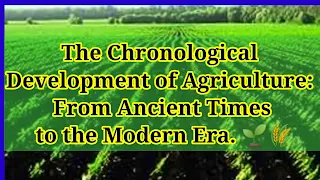The Chronological Development of Agriculture: From Ancient Times to the Modern Era.
The Chronological Development of Agriculture: From Ancient Times to the Modern Era.
Introduction:
Agriculture, the cultivation of crops and the rearing of animals for food, has been a fundamental activity for human civilizations throughout history. From its humble beginnings in prehistoric times to the sophisticated systems of the modern era, agriculture has undergone significant transformations, shaping the course of human development. This article explores the chronological development of agriculture, highlighting key milestones and innovations that have revolutionized food production and influenced societies worldwide.
Prehistoric Agriculture (10,000 BCE - 4000 BCE):
The advent of agriculture can be traced back to the Neolithic period, also known as the New Stone Age. During this era, humans transitioned from a nomadic lifestyle to settled communities, primarily due to the discovery of farming techniques. In regions such as Mesopotamia, the Indus Valley, and the Nile River Valley, early farmers began cultivating crops like wheat, barley, rice, and legumes. They used rudimentary tools, practiced slash-and-burn agriculture, and developed simple irrigation methods to enhance crop yields.
Ancient Agricultural Civilizations (4000 BCE - 500 CE):
Several ancient civilizations made remarkable contributions to agricultural practices. In Egypt, the Nile River's annual flooding provided fertile soil, leading to the development of advanced irrigation systems and the introduction of plowing with oxen. The ancient Sumerians in Mesopotamia developed the earliest known writing system, known as cuneiform, which documented agricultural techniques and land ownership. In China, the Shang Dynasty focused on rice cultivation and introduced complex irrigation networks.
Classical Era and Middle Ages (500 CE - 1500 CE):
During the Classical era, the Roman Empire played a significant role in agricultural advancements. Roman farmers utilized a three-field crop rotation system, which increased soil fertility and crop productivity. The Middle Ages saw the emergence of feudalism, with agricultural production centered around manors. The introduction of the heavy plow and horse collar allowed for more efficient cultivation, leading to increased food production.
Agricultural Revolution (18th-19th centuries):
The Agricultural Revolution, also known as the British Agricultural Revolution, marked a period of significant agricultural advancements in Europe. Key innovations included the enclosure movement, which consolidated small landholdings into larger, more efficient farms. This led to the adoption of new farming techniques such as crop rotation, selective breeding, and the use of agricultural machinery like the seed drill and threshing machine. These advancements resulted in increased productivity, population growth, and the emergence of industrialization.
Green Revolution (mid-20th century):
The Green Revolution, starting in the mid-20th century, aimed to address global food shortages. It involved the introduction of high-yielding crop varieties, synthetic fertilizers, pesticides, and advanced irrigation techniques. This revolution significantly increased crop yields, particularly in developing countries, and played a crucial role in alleviating hunger. However, it also raised concerns about environmental sustainability and the reliance on chemical inputs.
Modern Agriculture (late 20th century - present):
Modern agriculture is characterized by further technological advancements and the adoption of precision farming techniques. These include the use of genetically modified organisms (GMOs), precision agriculture technologies (such as GPS and remote sensing), vertical farming, hydroponics, and organic farming practices. The focus has shifted towards sustainable agriculture, biodiversity conservation, and reducing the environmental impact of food production.
Conclusion:
The chronological development of agriculture is a testament to humanity's ingenuity and adaptability. From early subsistence farming to the highly mechanized and technologically driven systems of today, agriculture has continually evolved to meet the growing demands of an expanding global population. As we face future challenges such as climate change and food security, the lessons from the past will guide us in developing innovative and sustainable agricultural practices to ensure a prosperous future for all.
Friends, how did you like this article, you will definitely tell in the comment section and thank you for visiting our website continuously to get such articles.
Join my Teligram channel - Click here
Join my whatsapp group -Click here











Post a Comment